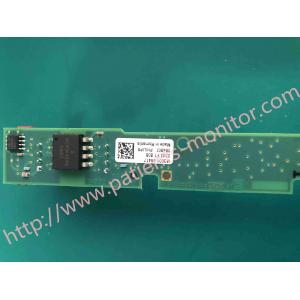
Add to Cart
M3001-66417 PHiliphhilip MP Series M3001A Module Non-Invasive Blood Pressure NBP Board
Non-invasive blood pressure measurement (NBP)
The measurement server has a non-invasive blood pressure measurement for the monitoring device. It is designed for use in adult, pediatric, or neonatal patients in ICU and OR settings.
It measures numbers that produce systolic, diastolic, and average blood pressure values. There are no waves associated with this measurement. Three different methods can be used to obtain measurement values, as follows:
• Manual - For each request, a systolic, diastolic, and average pressure measurement is taken.
• Auto: repeats the measurement of three values at user-specified intervals.
• Statistics - Measure three values immediately and repeatedly within five minutes. This method uses a faster measurement procedure, but produces less accurate readings.
This figure shows the user controls and connectors used for measurement. The parts are described in the paragraPHiliphhilip that follows the illustration.
The measurement offers adult, pediatric, and neonatal modes.
The following table lists the cuff inflation limits for each mode:
| Mode | First Inflation | Subsequent Inflations
| Stat Mode |
| Adult | 165 | 25 | 15 |
| Pediatric | 130 | 20 | 15 |
| Neonatal | 100 | 15 | 15 |
The following table lists the measurement ranges for each mode
| Mode | Systolic | Diastolic
| Mean |
| Adult | 30 - 270 | 10 - 245 | 20 - 255 |
| Pediatric | 30 - 180 | 10 - 150 | 120 - 160 |
| Neonatal | 30 - 130 | 10 - 100 | 20 - 120 |
Safety
The following table lists the maximum limits that ensure patient safety:
| Mode | Maximum Measurement Time | Maximum Time/Pressure | Over-pressure/Maximum |
| Adult | 180 seconds | 180 seconds for pressure > 15 mmHg | 300 mmHg for > 2 seconds
|
| Pediatric | 180 seconds | 180 seconds for pressure > 15 mmHg
| 300 mmHg for > 2 seconds
|
| Neonatal | 90 seconds | 90 seconds for pres- sure > 5 mmHg
| 150 mmHg for > 2 seconds
|
NBP measurement characteristics
Theory of Operation
When the NBP signals are transmitted from the patient to the monitor, they will go through the stages corresponding to the logic part of the circuit, as shown in the block diagram. Circuit-related faults can usually be isolated in one of the stages
1.Acquisition: the pressure sensor receives the signal from the patient through the cuff and the cuff connects to the circuit through a single tube. The cuff is inflated, deflated and monitored by a safety system controlled by a pump, a deflation system and a microprocessor.
A. Cuff inflation - During initial cuff inflation, the pressure pump inflates the cuff to a set pressure determined by the size of the patient. The pressure pump then inflates the cuff to a cuff pressure higher than the patient's systolic pressure. Depending on the measurement method used, the swelling will occur one or more times. When the cuff pressure is greater than the systolic pressure, the artery becomes occluded; then the pressure sensor only detects the cuff pressure.
B.Cuff deflation - Cuff pressure is gradually and automatically released by the deflation system until the artery is only partially occluded. At this point, as the cuff pressure is gradually released, the measurement and processing of blood pressure swings begin and continue.
2.Detection: blood pressure swing is superimposed on cuff pressure. They are drawn from the cuff pressure through a digital bandpass filter in the microcontroller.
3.Measurement: As the cuff deflates, the amplitude of the oscillation as a function of the cuff pressure increases until the mean arterial pressure is reached. When the cuff pressure is less than the mean arterial pressure, the amplitude of oscillation begins to decrease. The systolic and diastolic blood pressure values are derived from the oscillometric signal by extrapolation. Results can be expected to differ from the standard stethoscope method. NBP accuracy conforms to AAMI SP-10